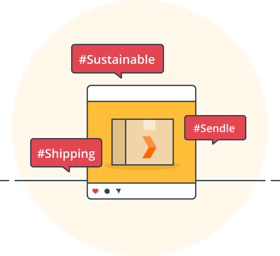Instagram has grown far beyond sharing photos and videos. The crucial hashtag feature adds value for businesses to the content they create by making it easier for your potential customers to find you and the products you’re selling.
It also creates a pathway to reach your target audience so they can engage with your brand messaging.
Instagram has over 1 billion monthly active users globally. The United States alone currently has the highest number of monthly Instagram users at 130 million, followed by India (100 million) and Brazil (91 million).
As this number continues to grow, Instagram marketing is a must for every business that wants to grow and thrive.
In this guide, we'll show you the basics of Instagram hashtags and how they can help your business profit.

What are Instagram hashtags?
Instagram hashtags are a combination of letters, numbers, or emojis preceded by the # symbol to categorize content and make it more discoverable.
By clicking an Instagram hashtag, you can access a page that displays all the posts tagged with that hashtag.
If you’ve ever wondered why people use so many hashtags, they do it to try and get their posts seen by as many people as possible. More eyes on your brand means more sales for your store.
Appending relevant hashtags onto your super compelling Instagram captions is a great way to increase your engagement.
Why use Instagram hashtags?
Hashtags allow you to appear on the hashtag feed page, scaling your reach and impact as much as possible.
For the specific people that follow the hashtags you’re using, your posts appear in their feed even if they don’t follow you.
This happens because your hashtags align with their interests. If they like your post and click through to your profile, that’s the first step in following or even purchasing.

How to create an Instagram hashtag strategy
Yes, hashtags can be powerful to help you build your visibility but to really have an impact you have to be using the right hashtags.
Knowing the right hashtag to use and when to use them are crucial to your Instagram success.
Here are some strategies you can use for your hashtagging.
Identify your hashtag number and placement
When it comes to hashtag placement, you need to decide how many you’re going to use and where you’re going to put them.
You can use up to 30 but aim for at least 5-10 relevant words or phrases.
You can either hashtag specific words in your caption, put the hashtags in the first comment, or hide them in the caption.
How to hide your hashtags in the caption
Some brands prefer hiding hashtags in the caption.
Doing it this way means you can still get the benefit of the hashtags without the visual clutter as people have to click ‘see more’ to see the hashtags.
If you’d like to give it a try, insert some line breaks underneath your caption. Type a period or asterisk on each line to keep the line empty, then enter your hashtags at the bottom.
If Instagram doesn’t keep your formatting, type your caption in a different text editor like Google Keep or Evernote then copy and paste it to Instagram to keep the formatting.
Research popular hashtags related to your brand
Researching hashtags is an integral part of your strategy.
A fast way to check for the high-performing hashtags is by checking the hashtags that influencers and brands like yours are using.
Chances are a lot of people in your industry will be searching with these exact tags. If you search a hashtag, you can see how many posts it has.
This’ll give you an idea of the reach you might get as well as how competitive it is.
As well as spying on influencers and brands, hashtag finders or hashtag generator tools can help you discover new and relevant hashtags and save you some time in generating them.
If you use a generator, make sure to check the hashtags carefully first and be aware that many other people might be using the same mix of auto-generated tags.
The good thing about popular hashtags is that more people see them. The downside is that more people are creating content for those hashtags so it’s more competitive.
Ideally, you’ll end up with a mix of popular general hashtags and more specific tags.
Understand the Instagram hashtags before using them
Don’t use a hashtag just because it’s popular!
Make sure a hashtag is relevant to you and your audience first, otherwise it’s a waste of your time and resources.
Hashtags can often be slang or culturally contextual and they might not always mean what you think they mean. If in doubt, do some scrolling before using it.
Create a hashtag document
Creating a hashtag document for all the verticals your brand focuses on will make your life a lot easier.
It’ll save you from going through the tiring and time-consuming process of researching new hashtags every time you need to post something.
Although you might still do a daily search of new or branded hashtags, having a hashtag bank means that you have something to fall back on.
When it’s time to post, just consult your document, choose the appropriate ones for the caption you’re creating and keep the rest for future use.

Types of Instagram hashtags
There are different types of hashtags, usually classified according to what purpose they serve.
Let’s explore some types of Instagram hashtags so you don’t mix things up when creating your hashtag strategy.
Product or service hashtags
These hashtags relate to the product and service that a business offers. Usually, these hashtags are quite general.
Examples include things like #graphicdesign and #designershoes.
Industry or niche hashtags
These types of hashtags represent a peculiar industry or niche.
Examples could be #contentmarketing, #handmadebiscuits, or #sustainablymade
Branded & campaign hashtags
Branded hashtags are often used to build communities around your brands. Your brand name or tagline could be used in this way, or a tagline from a specific campaign you’re running.
#Nike or #ShareACoke are good examples of this.
User-generated content hashtags
Learning how to regram other user’s amazing posts isn’t the only way to utilize user-generated content. You can also use hashtags that come from what your audience is saying (and hashtagging) about your products or similar ones.
These can be a goldmine for engagement because using them is essentially meeting your audience where they already are.
Examples of these are #instadaily, #wanderlust, and #fitspo
Popular Instagram hashtags
These are evergreen hashtags that people will always use no matter what.
Examples are:
#love, #instagood, #fashion, #photooftheday, #beautiful, #art, #photography, #happy, #picoftheday, #cute, #follow, #tbt, #mondeymotiation, #followme, #nature, #like4like, #travel, #instagram, #style, #repost, #summer etc.
#InConclusion
Instagram hashtags are crucial for improving engagement and increasing your follower count, but you have to use them correctly to get the results you want.
After reading this guide, you should have a strong basis to go out, try your hand at hashtag strategy, and see how it benefits your business!


